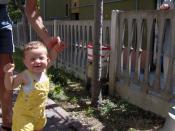#1 Urie Bronfenbrenner, an American psychologist, developed the Ecological Systems Theory in order to further discuss and explain child development. Bronfenbrenner's theory explains that there are certain cultural and social factors within a child's immediate environment that influences the child's development and experience. Within the immediate environment of the child, there are many levels, or systems, that can affect and influence child development.
There are five systems that Bronfenbrenner indicates in his theory on child development. The first system in the Ecological Theory is microsystem, which is the child's closest layer. The microsystem is the immediate environment in which the child lives in. Any immediate interaction with the child is part of the microsystem, such as at school, day care and with family and peers. Such relationship can certainly influence a child's development psychologically, biologically, or etc. As a child develops, the child is very susceptible to his or her immediate surroundings and interaction within the microsystem.
The ways in which a child is treated within the microsystem and also the ways in which the child reacts are also important factors in the microsystem.
The second system is the mesosystem, which is a system that is comprised by the linkages between the microsystems. Such an example includes the possible connection between a child's immediate surroundings of school and home. More specifically, the connection with a child's school and home is a parent teacher meeting or conference, in which the child is involved in.
The third system of Bronfenbrenner's theory on child development is the exosystem, which includes other places or people that indirectly influences a child's development. One of the most common examples of an exoskeleton is the workplace of the child's parents. Although the child will most likely not interact within the parent's workplace, there are many factors...


